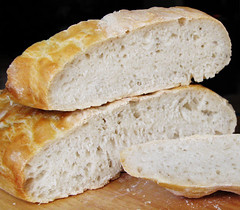Foccacia (with how-to)
Undaunted by my whole one-hour kneading experience before, I rushed headlong into my next bread-making experience, this time with Foccacia, which means "focus," referring to the hearth in which the bread is baked. It's a relatively flat Italian bread, and always the one I scoop out of the bread basket in Italianni's instead of the Ciabatta, and perfect with olive oil and balsamic vinegar, but also for other uses like Paninis and such. I used Dan Lepard's recipe and his method... But I still don't have a heavy-duty mixer. By the way, I got the bread flour, which is not available in any of the major groceries, from the neighborhood (sari-sari)store. They don't bake their own bread, but I struck a deal with them and they asked their supplier to give them a few kilos of bread flour, which I got for PhP40 ($1) a kilo. I'm pretty sure they've already stacked on their profit, but that's still a good deal for me. (Instructions follow)
The recipe is, without breaking copyright law again, 1kg of strong white flour, with 68% bottled spring water (I used Viva), 2% salt, 0.7% dry yeast, 1 tbsp olive oil, and 1 tsp sugar. Make the starter by combining the yeast, water (I no longer warmed it as it is 33°C here today), and half the flour. Wait until it rises by about one-third and is clearly active (has a lot of bubbles). I realized that the recommended times for rising and such vary tremendously between here and the United Kingdom where the book was published, so from today's experience I now use 1/4 the recommended time. So when they say about 2 hours for the starter to become active, I only waited 30 minutes.
Make a well in the remaining flour and add the starter and the rest of the ingredients, then mix with a strong wooden spoon.
Here's where I digress from the original recipe due to my lack of a mixer: dump the dough onto your working surface and knead until it becomes elastic and a finger's identation will spring back. This time, it took me about ten minutes.

Form into a ball, place in an olive-oiled bowl, and brush the surface with olive oil. Cover with a towel and leave to proof for 30 more minutes in our hot weather (so that's 2 hours in non-equatorial weather), until a finger's indentation will slowly spring back.
Form into a rough rectangle, then fold into thirds and then into half in the other direction.

Cut in half and shape each into a 20x30cm rectangle and fit into a floured sheet pan. Cover with a towel and leave to proof again for 15 minutes in hot weather. Dimple the surface 1cm deep with your fingers and drizzle the top with olive oil, and sprinkle with coarse salt.
Bake in a preheated 250°C (482°F) oven for 10 minutes, then lower the temperature to 200°C (398°F) and bake for 20 minutes more.
Lesson learned:
The dough is supposed to be a little sticky. Don't be afraid to add water (by moistening your hands if needed).















































